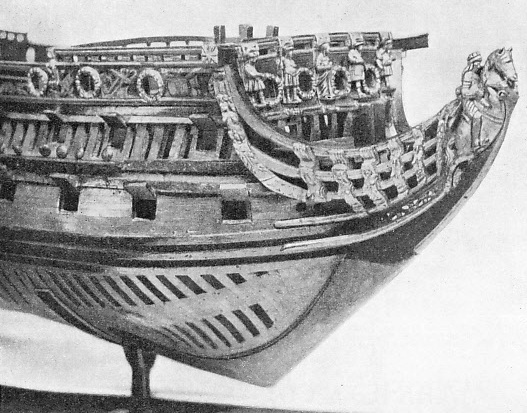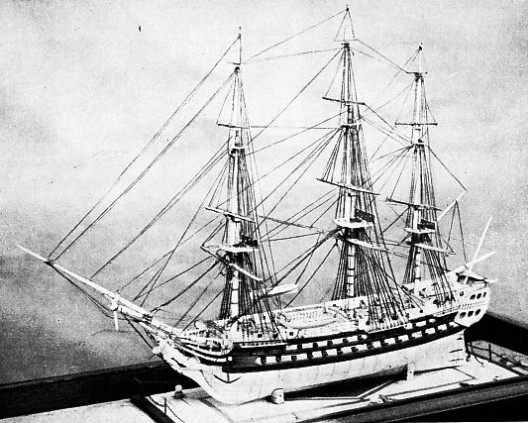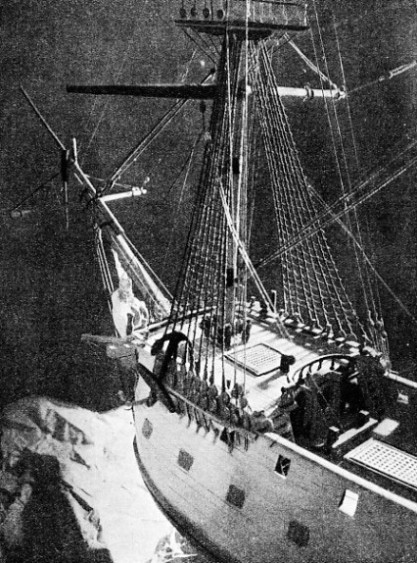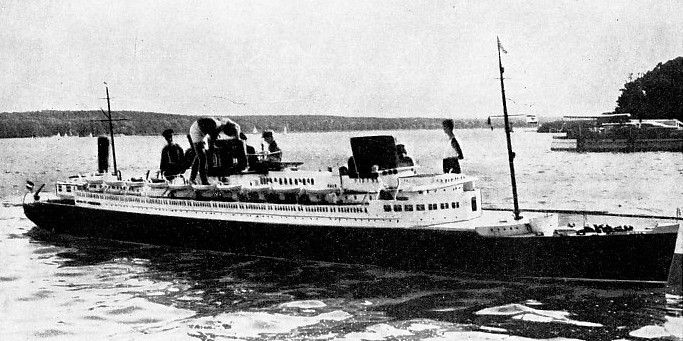

© Shipping Wonders of the World 2012-

Marine Models
Miniature representations of ships attract their enthusiasts all over the world. Ship models may be ornamental (“glass-
FOUR HUNDRED YEARS OF PROGRESS in the Royal Navy are represented by the juxtaposition of these two models from the collection of Charles J. Hampshire, to a scale of 64 feet to one inch. The sailing vessel is the Tudor galleon Mary Rose, built in 1509; the battle cruiser is H.M.S. Hood, launched in 1918. The Hood is the largest vessel in the British Navy, having a displacement of 42,100 tons.
THE shipbuilding industry probably has made more extensive use of models than any other. In the chapter “How the Modern Ship is Tested”, the part played by hull models in the evolution of great ocean liners has been fully described. Experiments with accurate scale-
Further, shipping companies do not dispense with models on the launch of a new vessel. It is a well-
Models of that type, however, cost hundreds, even thousands, of pounds and are necessarily the work of professional model makers who specialize in the work. But the building, sailing and collecting of model ships is of interest to the amateur also. Ship modelling has its following among
thousands of people all over the world. The marine model enthusiast has a wonderful range of activity open to him and his fascinating hobby is well catered for by firms which supply model ships’ fittings and materials. A first-
Marine models may be divided roughly into two groups — ornamental or “glass-
Historical models need not be exclusively of the glass-
The majority of working models are usually amateur-
A distinct type of power-
Miniature modelling has now been brought to a fine art, and the famous Hampshire collection of miniature ships at the Institute of Marine Engineers, London, will amply repay a visit. The models are the work of Charles J. Hampshire, M.I.Mar.E., who has made the work a life-
The ships are all shown sailing on a sea of putty. The putty is worked into an exact representation of the sea. The ship’s bow wave and wake are faithfully portrayed and the colouring is perfect.
A roll-
Decks are of Bristol-
Miniature Ships for Titania’s Palace
Wireless aerials are made from fine copper wire, the finest copper wire made, as used for certain components in radio sets. Some of the model liners in the Hampshire collection have over 1,000 port-
Another detail to which careful attention is paid is the shaping of the tissue paper flags and ensigns so that they appear to be fluttering in the breeze. It is this careful attention to the smallest details that renders these models such perfect examples of craftsmanship.
Many famous ships are represented in the Hampshire fleet, and many models have taken approximately twelve months to build. Some models represent the painstaking work of two years. Christopher Columbus’s ship, the Santa Maria, was modelled for exhibition at Nassau, in the Bahamas. It was at Watling Island, in the Bahamas, that Columbus first set foot in the New World.
A miniature, so small that it can be hidden behind a penny, was made of Sir Francis Drake’s Golden Hind for Sir Neville Wilkinson to exhibit in his marvellous Titania’s Palace — the tiny mansion that ranks as a supreme example of miniature modelling and has earned, by exhibition, large sums of money for charity. The model ship was built to commemorate the visit of King Edward VIII, as Prince of Wales, to South America in 1934, where he opened an exhibition (that included Titania’s Palace) at Buenos Aires.
Another model of a French 74-
Another old-

BOWS OF A MODEL SHIP BUILT IN 1640. The model, of H.M.S. Prince Royal, is a fine example of the collection in the Nautical School training ship Mercury, at Hamble, Hants. It has been proposed to sell this collection to provide a perpetual endowment for the training ship.
Among the miniature warships is a composite model depicting the “Jubilee of the Ironclad”. In it are represented H.M.S. Thunderer, launched at Blackwall in 1911, and H.M.S. Warrior of 1861, the first British sea-
The Hampshire collection has also a composite model illustrating four hundred years of progress in naval architecture. The battle cruiser Hood, launched in 1918, is shown with the Tudor galleon Mary Rose, built in 1509.
The miniature liners include the Queen Mary, made to the scale of 64 feet to one inch. Alongside the Queen Mary, but sailing in the opposite direction, is shown, to the same scale, a miniature of the Cunard Line’s first steamer, the Britannia of 1840, equipped with paddles and sails. The two ships provide a striking contrast.
Another interesting composite model that provides a comparison between two ships separated by a century of time represents the William Fawcett, built in 1829 and chartered by the Peninsular Line, alongside the P. and O. liner Viceroy of India, built in 1929, and the largest turbo-
The Cunard White Star motor liner Britannic is also represented in the collection. One of the most striking exhibits among the liner models is one of the Canadian Pacific vessel Empress of Japan. The liner is represented “dressed” with flags, every one of which is an exact replica in miniature of its counterpart in the International Code of Signals. She is shown towed by two small tugs which, as with the liner, are complete in every detail. Included in the fleet of miniatures built by Mr. Hampshire are many models of ships that have played important and dramatic parts in maritime affairs shortly before and during the war of 1914-
One such ship reproduced is a model of the P. & O. liner Medina, which was converted as a Royal yacht to carry King George V and Queen Mary to India in 1911. The tragedy of the Titanic has been commemorated by a complete scale model only 13½ in. long. This now rests in the Institute of Marine Engineers at the foot of the memorial to the thirty members of the engine-
Scale Model 22 Feet Long
In happier vein are the circumstances attaching to the building of a miniature Shamrock IV, one of Sir Thomas Lipton’s world-
In contrast with these wonderful miniatures we have the much larger scale models, complete in every external detail, that usually emanate from the works of the leading professional firms in the country.
The scale models built by professional firms for shipping companies are the work of highly skilled craftsmen who use official drawings of the ship to be modelled. As the work on the model progresses the dimensions are carefully checked to ensure accuracy in every detail. The hulls of these publicity models contain no machinery, but comprise a number of planks of wood screwed and glued together in successive layers.
Sometimes a solid block of specially selected timber is used instead of planking, and the hull may be partly hollow to reduce the weight of the model and facilitate its transport. This is an important consideration, because some ship models exceed 20 feet in length.

REPRESENTING A FAMOUS FRENCH WARSHIP, the Temeraire, built at Toulon in 1749. This model from the collection in the Nautical School training ship Mercury, was built of bone. The Temeraire was captured from the French by Admiral Boscawen in 1759,when he defeated the French fleet off Gibraltar. Three British warships have been called Temeraire. The first was the “Fighting Temeraire”, captured from the French at the battle of the Nile. In 1875 a newly-
A 20-
During 1936 a model of the Queen Mary was exhibited for many weeks at the Science Museum, South Kensington, and afterwards in many parts of Great Britain. Such large models are, however, exceptional, and the average model is between 4 and 8 feet in length. When the hull of the ship has been completed the various components of the superstructure are placed in position and the painting and the final assembly of the fittings are proceeded with. Model ships’ fittings such as stanchions, portholes, bollards, davits, ventilators, blocks and many other items are made by a system of mass production. This is necessary because a modern liner model will require about 1,000 portholes alone, apart from other details.
The final assembly of a model is generally carried out in a large, well-
Another branch of modelling that has proved of great value to shipping companies is the representation of interiors. A model of a cabin or state-
An important aspect of marine model work that is usually undertaken by commercial firms is the supply of waterline scale models to naval authorities. These models represent only the above water portion of warships and they can be moved about on a flat surface for the purpose of studying naval tactics. The model warships are made to a small scale and sufficient detail is included to enable them to be identified in silhouette. Most naval officers are familiar with the silhouettes of ships in their own navies and with those of the principal warships of foreign Powers.
Commercial firms of model shipbuilders in Great Britain have not, however, neglected the recreational aspect of the work. Whole fleets of water-
“Bread-
For building the hulls, drawings are required and may sometimes be obtained from the shipping companies or more usually from the technical press. The essential drawings are the “body plan”, showing the section contours of the hull at the transverse bulkheads, and the side elevation and deck plan.
The usual method is for the side elevation to be divided by a number of horizontal or “water” lines and by vertical bulkhead lines corresponding to those on the body plan. The same number of wooden planks as water lines is then marked with a line down the centre and this is divided by cross lines that represent the requisite number of bulkheads. The shape of the hull, at the water levels, is then marked out on the planks from the body plan. The planks are cut to the marked outlines and the central portions are also cut out, to leave an elongated ring with thin sides. The cut planks are then glued together in layers, resembling outwardly a series of terraces or steps. These steps are cut away, leaving a hollow wooden hull, true to scale. This is the so-
Many prefer to build hulls by the “dug-
These methods are sometimes varied to meet the model builder’s requirements. Another means adopted in hull construction is to make use of ribs and planks as in the old-

MODEL OF THE AIRCRAFT CARRIER GLORIOUS, in the Royal United Service Museum, London. The model took over a year to complete. The Glorious, formerly a cruiser, was launched in 1916. She has a displacement of 22,500 tons and a designed speed of 30 knots. The official complement of aircraft is forty-
Checking for size and contour is done by templets from the body plan. Some hulls are plated on metal framework — as in the “real thing”. Rivets in such instances are generally dispensed with and joints are made by soldering.
Superstructures are kept as light as possible, and fittings may be made from “odds and ends”. One of the advantages enjoyed by the model shipbuilder is the comparative cheapness of the materials required. Fittings may be bought and an immense range is available from specialist firms.
Machinery for model steamers and motorships may take many forms, depending on the type of model and the use to which it is to be put. For small models the clockwork motor provides an inexpensive and reliable means of propulsion. The use of clockwork does not imply that the model is a toy. The miniature ship may be too small for any other type of motive power, or the superstructure and fittings may be too delicate to risk close proximity to a steam engine and boiler. For this reason so many of the larger models, especially power-
Steam, however, stands favourite with the model marine engineer. It is not usual to reproduce the engines of a model steamer exactly to scale. Engines vary in size, design and complication. They range from working model triple-
Speed and Power
Types of boilers and methods of firing also present a wide choice. Again, the simpler boilers follow old-
A working model steamship takes a considerable time to build, and it is unusual to find an owner with more than two or three vessels. Occasionally, however, an enthusiastic ship-
Strict attention has been paid to the correct proportions of the steamers and their appearance is realistic. Two of the vessels, 20 in. long, represent L.N.E.R. Hook of Holland passenger steamers, and there are some 20-
Most of the larger fleets of model steamers are to be found at the headquarters of the numerous clubs in Great Britain and other countries. The important British clubs are affiliated to the Model Power Boat Association, founded in 1924. The Association controls all racing competitions between the various clubs and exists for the purpose of promoting interest in the design of model power boats.
Most club members own at least one model, and that has probably been made in a home workshop after much patient experiment and by the exercise of careful craftsmanship. Warships never fail to attract the model maker. The largest battleships and battle cruisers make attractive subjects for modelling, and many remarkable ships, driven by steam or electricity, have been built. The difficulty with such models, however, lies in their size — a 6-
Battleships modelled to a small scale lose much of their impressiveness as working models because it is impossible to include the necessary detail. Partly for this reason the light cruiser and the torpedo-

INFINITE PATIENCE AND EXCEPTIONAL SKILL are needed by the maker of a miniature ship, and are exemplified in the detail of this model, by Norman Lindsay. The smaller scale employed by Charles J. Hampshire requires the employment of special materials. The hulls are carved from cedar wood that has been seasoned for fifty years. Decks are of Bristol board and the hand-
The keel of the Verdun model is a brass bar, 3/16 in. by ⅝ in., to which the keel plates are riveted and soldered. The brass ribs are 1/16 in. by ½ in. in section. The metal hull was built up on a carved wooden block and is stiffened at deck level amidships by strips of oak that form a seating for the removable aluminium deck. The watertight joint between deck and hull is ingenious. It consists of a continuous length of rubber “cycle-
All controls are operated from above the deck, which is removed only before and after a cruise. The fore deck and superstructure are hinged to provide access to the blow-
A single propeller is used instead of the twin screws of full-
A mechanical pump and a hand-
Another type of vessel that is deservedly popular with the model maker is the coasting steamer. A splendid little model, the Florence, was built by W. Melville. This miniature steamer is only 25 in. long overall, with a breadth of 5 in. and a depth of 4 in., but she is fitted with a wonderfully compact power plant driving a single screw.
Run of Four Hours
The hull is of the wooden “dug-
Despite its small dimensions great care has been taken in the design of the engine. The crank is double-
To save weight the components of the cylinder were silver-
Steam enters the lubricator through a small hole and on meeting the oil a small quantity condenses. The resulting drop of water sinks through the oil, of which it displaces a portion that is forced into the valve chest and lubricates the valve and piston. At the end of a run condensed water is removed, through a drain valve, from the lubricator, which can then be replenished with oil.
The model engine of the Florence works a feed pump, only ⅛-
The “boiler-

THE TITANIC IN MINIATURE, a model of the ill-
This generator was later replaced by a model Thornycroft boiler. This boiler is only 3½ in. long overall and 4 in. high, but it closely follows marine practice and works at a pressure of 110 lb. The main steam and water drum has a diameter of 1½ in. and is fitted with a baffle plate above the water level. At one end of the main drum are fitted the safety valve and the feed water and steam valves and the “downcomers” leading to a pair of water drums, ⅝ in. diameter, at the bottom of the boiler.
The water drums are connected also to the main drum by nests of inclined tubes. The forward end of the main drum is of special interest. It is provided with a flange and ring, between which is secured a disk of in. plate glass that provides an end-
In contrast with the Florence is the large model cargo steamer built by V. Wall. This vessel, the Vernon, is 6 ft. 10 in. long, with a beam of 12 in. and a depth of 10 in. She weighs 120 lb.
The model of the Vernon has a plated metal hull and is fitted with a compound engine driving a single screw of 4½ in. diameter. The high-
One of the finest model cabin cruisers in existence is Mr. Eastaugh’s ship Tony. This steam-
Miniature Racing Craft
Model petrol engines are more often used, however, for driving the miniature racing craft about which so little is known outside club circles. Speeds of over 40 miles an hour have been reached by boats only 3 feet long. The hulls of these speed craft closely follow, in design, the lines of large racing motor boats and are provided with a step on the underside. The under surface of the hull is thus divided into two “planes” on which the boat rises at speed and so skims the top of the water with the minimum of resistance.
The building of light but powerful petrol engines for model racing boats has reached a high standard and two-
One of the largest of these model speed boats is the Betty, built by S. L. and M. J. B. Innocent. She attained a speed of 41·18 miles an hour. She is a single step hydroplane, 36¼ in. long and with a beam of 11 in. The model weighs 14½ lb. complete. The engine is a single-
Racing model yachts represent the highest form of craftsmanship and their finish and fittings are superb. In the British Empire model yacht sailing and racing is carried on by a number of clubs under the Model Yachting Association, with headquarters in London. Model yachting is not confined to Great Britain, and the International Yacht Racing Union controls the racing events in which compete the best and fastest yachts of some twenty nations.
The sailing of model yachts provides an opportunity for the exercise of great skill in adjusting the sails, the rigging and the automatic gear that attends to the steering while the “skipper” necessarily stays on shore.

WORKING MODEL OF A GERMAN RECORD-
You can read more on “From Tudor to Victorian Times”, “Merchant Ship Types” and
“Ships in Miniature” on this website.
